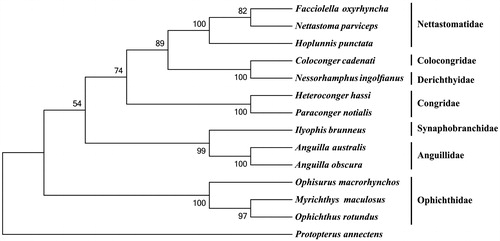Abstract
The complete mitochondrial genome of Ophichthus rotundus was sequenced in this study. The genome sequence is 17,785 bp in length, comprising 13 protein-coding genes, 22 tRNA genes, 2 rRNA genes, and 2 control regions. Overall base composition is 30.59% A, 24.94% T, 17.01% G, and 27.46% C. The result of phylogenetic analysis indicates that O. rotundus mitogenome is close to that of M. maculosus, which are nested within the family Ophichthidae.
The order Anguilliformes contains 19 families, 159 genera, and about 938 species, most of which are marine origin. The Ophichthidae is a family of Anguilliformes, whose distinguishing features are posterior nostril usually within or piercing upper lip; median supraorbital pore in frontal sensory canal; caudal fin absent; pectoral fins present or absent; vertebrae 110–270 (Nelson et al. Citation2016). Ophichthus rotundus belongs to the family Ophichthidae, which distributes in Northwest Pacific, mainly including East China Sea and west coast of Korea (Zhang Citation2010). In this study, the complete mitochondrial genome of O. rotundus was determined. Fish sample was collected from the Changjiang Estuary (30°51′16.24″N, 121°54′46.51″E), Shanghai, China. The specimen is stored in the Laboratory of Ichthyology, Shanghai Ocean University, with an accession number 20160421. The sample DNA is available on request.
Mitochondrial DNA is a maternally inherited circular genome that serves important functions in metabolism and population genetics (Boore Citation1999). The complete mitogenome of O. rotundus (GenBank accession number: KY081397) is 17,785 bp in length, with overall base composition of 30.59% A, 24.94% T, 17.01% G, and 27.46% C. With the exception of two control regions, the genome content of O. rotundus includes 2 rRNA, 22 tRNA, and 13 protein-coding genes, plus the putative control region, as found in other vertebrates (Inoue et al. Citation2004). The original arrangement of protein-coding genes of order Anguilliformes is nad1–nad2–cox1–cox2–atp8–atp6–cox3–nad3–nad4L–nad4–nad5–nad6–cob. The mitogenome of O. rotundus exhibits the translocation of nad6: nad1–nad2–cox1–cox2–atp8–atp6–cox3–nad3–nad4L–nad4–nad5–cob–nad6 (Shen et al. Citation2014). Apart from the ND6 gene and eight tRNA genes (tRNA-Gln, Ala, Asn, Cys, Tyr, Ser, Glu, and Pro) encoded on the L-strand, most genes are on the H-strand. 12 of 13 protein-coding genes start with a common initiation codon ATG, while COI utilizes GTG. ND1, COI, ATP8, ND4L, and ND6 end with TAA; ATP6 and COIII with TA– (incomplete stop codon); ND2, COII, ND3, and ND4 with T–– (incomplete stop codon); ND5 and Cytb with TAG.
To investigate the phylogenetic relationship among the order Anguilliformes, we downloaded the mitochondrial genome sequences of 12 currently available species of Anguilliformes, including Anguilla australis (AP007235), A. obscura (AP007247), Coloconger cadenati (AP010863), Facciolella oxyrhyncha (AP010866), Heteroconger hassi (AP010859), Hoplunnis punctata (AP010865), Ilyophis brunneus (AP010848), Myrichthys maculosus (AP010862), Nessorhamphus ingolfianus (AP010850), Nettastoma parviceps (AP010864), Ophisurus macrorhynchos (AP002978), and Paraconger notialis (AP010860), together with an African lungfish Protopterus annectens (NC018822) as an outgroup species. The phylogenetic tree was constructed using MEGA6 (Tamura et al. Citation2013) for neighbour-joining method. Tree topology was evaluated by 1000 bootstrap replicates. The result indicates that O. rotundus mitogenome is close to that of M. maculosus, which are nested within the family Ophichthidae ().
Disclosure statement
The authors report no conflicts of interest. The authors alone are responsible for the content and writing of the paper.
Additional information
Funding
References
- Boore JL. 1999. Animal mitochondrial genomes. Nucleic Acids Res. 27:1767–1780.
- Inoue JG, Miya M, Tsukamoto K, Nishida M. 2004. Mitogenomic evidence for the monophyly of elopomorph fishes (Teleostei) and the evolutionary origin of the leptocephalus larva. Mol Phylogenet Evol. 32:274–286.
- Nelson JS, Grande TC, Wilson MVH. 2016. Fishes of the world. 5th ed. New York (NY): John Wiley and Sons, Inc.
- Shen X, Tian M, Meng XP, Cheng HL, Yan BL. 2014. Eels mitochondrial protein-coding genes translocation and phylogenetic relationship analyses. Acta Oceanologica Sinica. 36:73–81.
- Tamura K, Stecher G, Peterson D, Filipski A, Kumar S. 2013. MEGA6: molecular evolutionary genetics analysis version 6.0. Mol Biol Evol. 30:2725–2729.
- Zhang 2010. Fauna Sinica, Osteichthyes, Anguilliformes & Notacanthiformes. Beijing: Science Press.

